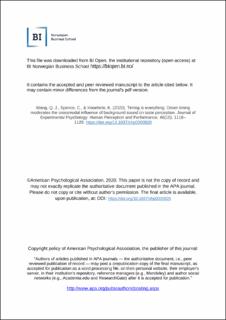| dc.description.abstract | Recent evidence demonstrates that the presentation of crossmodally corresponding auditory stimuli can modulate the taste and hedonic evaluation of various foods (an effect often called “sonic seasoning”). To further understand the mechanism underpinning such crossmodal effects, the time at which a soundtrack was presented relative to tasting was manipulated in a series of experiments. Participants heard two soundtracks corresponding to sweet and bitter tastes either exclusively during or after chocolate tasting (Experiment 1) or during and before chocolate tasting (Experiment 2). The results revealed that the soundtracks affected chocolate taste ratings only if they were presented before or during tasting but not if they were heard after tasting. Moreover, participants’ individual soundtrack–taste association mediated the strength of the sonic seasoning effect. These results therefore imply that the modulatory effect of sound on taste was not driven by retrospective interpretation of the taste experience, but by mechanisms such as priming and crossmodal association. Taken together, these studies demonstrate the complex interplay of cognitive mechanisms that likely underlie sonic seasoning effects. (PsycInfo Database Record (c) 2020 APA, all rights reserved) | en_US |
